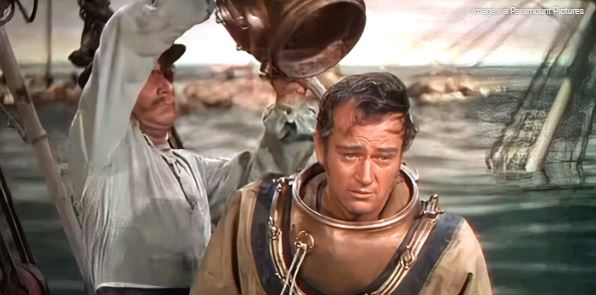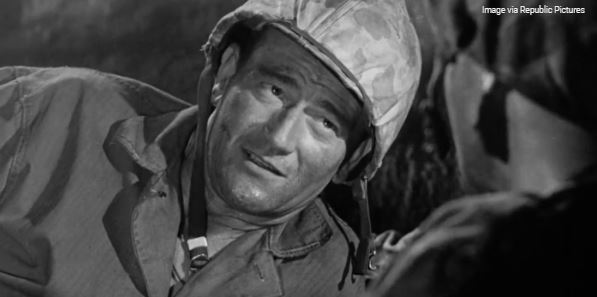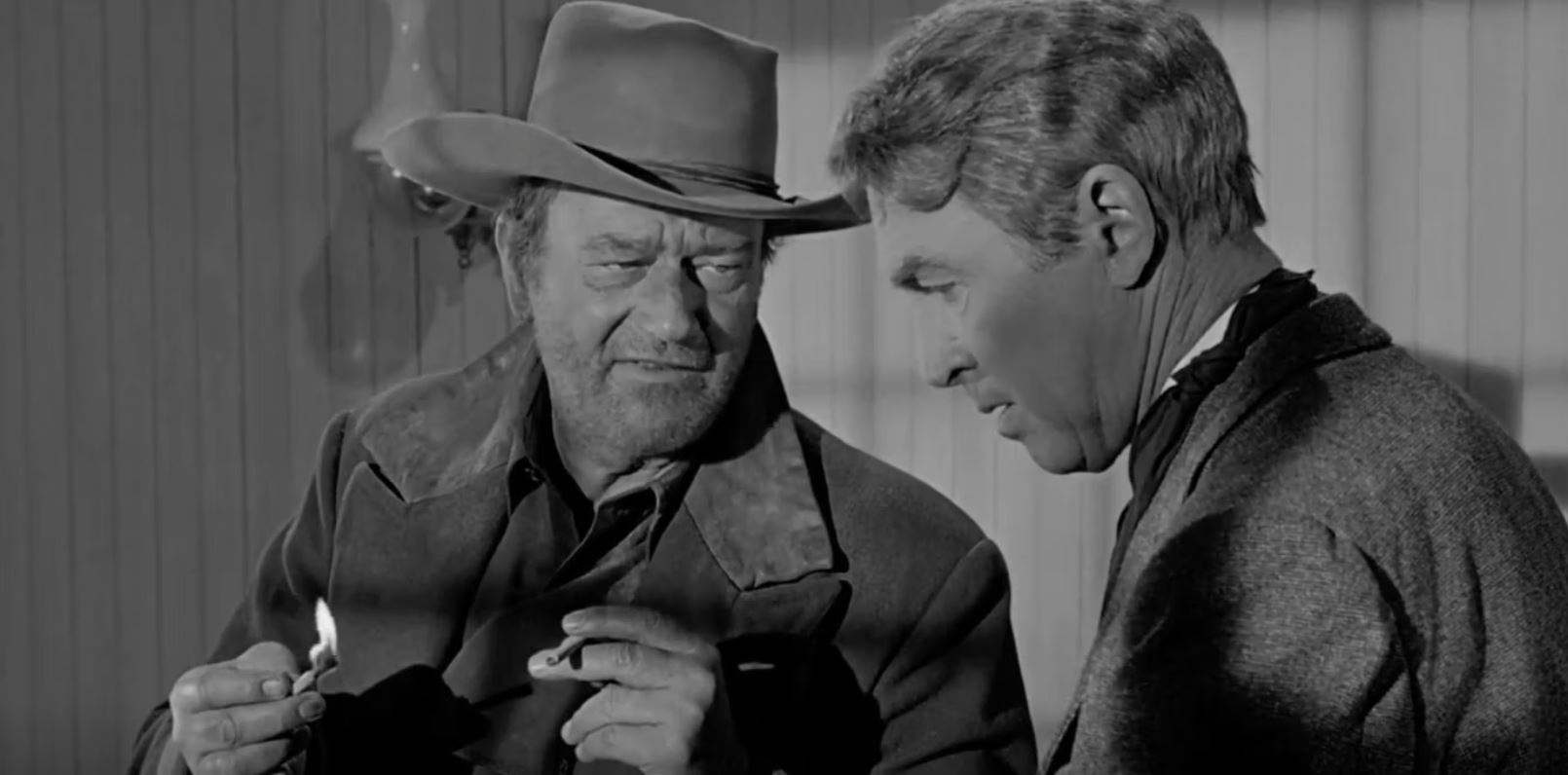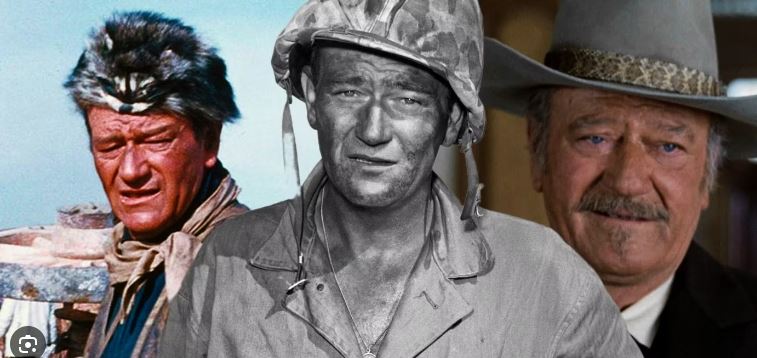There are several famous actors who haven’t died on screen, but John Wayne isn’t one of them. The Duke is widely recognized as a Hollywood icon with a legacy in Westerns and war movies. His career delivered many memorable characters, scenes, and moments across cinematic+ history. There is that iconic final shot of The Searchers, where he walks into the dusty horizon for whatever next adventure will come his way, but not even a heroic figure like Wayne could escape having his characters die. In total, there are nine characters he played that have confirmed deaths. He got his first Oscar nomination for a film that killed him, and in his final Western, there was sadness for his older gunslinger due to the actor’s own declining health. John Wayne’s onscreen deaths were all either shocking, well-deserved, or unique.
What Happens to John Wayne’s Less Heroic Men?
In West of the Divide (1934), Wayne plays dual roles as Ted Hayden, who shares a striking resemblance to the killer outlaw Gat Ganns. Early on, Ganns bites the dust when he is poisoned by a waterhole, letting Ted Hayden take over his identity to infiltrate a gang to find who killed his father and locate his missing brother. A death scene like this is the only logical ending for Ganns, ridding the world of his chaos. In Wake of the Red Witch (1948), Wayne is Captain Ralls, who could have prevented his watery death. While Ralls isn’t as villainous as Gat Ganns, he indulges in violent behavior whenever he gets drunk. He intentionally crashes his vessel, the Red Witch, out of revenge on his boss. This self-destructive behavior from Ralls stems from a romance that ended in heartbreak and death, marking him as a great contender to be cursed as captain of the Flying Dutchman. When Ralls has to descend to the sunken Red Witch, the unstable vessel shifts off an underwater ledge. The air hose to Ralls’ scuba suit is severed and a closeup of his mask shows the water filling inside, a wretched death for someone who could never let go of his inner turmoil. Interestingly, this is not the only time John Wayne meets a watery death on screen. In fact, Reap the Wild Wind gives viewers one of his unique deaths.
‘Reap the Wild Wind’ Gives John Wayne One of His More Creative Movie Deaths

Reap the Wild Wind (1942) is about a love triangle between Loxi Claiborne (Paulette Goddard), Captain Jack Stuart (Wayne), and Steve Tolliver (Ray Milland). Things get messy when Jack is caught purposely crashing his ship, drowning Loxi’s cousin who was a stowaway, and Steve wants him punished for it. The men agree to locate evidence at the shipwreck, but when a giant squid attacks Steve, Captain Jack Stuart redeems himself by dueling the big squid prop with a knife. Black ink clouds everything until the only man to resurface is Steve. The tough-guy persona Wayne portrayed made him ideal as a leader, and the Western and war movies he is best known for helped turn him into a patriotic symbol who must commit a great sacrifice to save the day.
John Wayne’s War Movies Showed a Different Side to the Actor

The Fighting Seabees (1944) is a fictional account of how the U.S. Navy’s “Seabees” were formed for World War II. Wayne’s Lt. Cmdr. “Wedge” Donovan wants his men to be properly armed for the approaching Japanese army, but the enemy forces prove too strong. Donovan makes a last stand with a bulldozer and explosives to stop an attack by the Japanese, killing himself in the process. In Sands of Iwo Jima (1949), Wayne got his first Oscar nomination as Sergeant Stryker, a role that also gave him a shocking demise. Right as the American forces seem to become victorious, Stryker is shot and the men in his unit discover a letter he wrote to his son saying everything he never had the chance to.
Stryker’s men raise the American flag in honor of their fallen leader, creating the iconic image of the Battle of Iwo Jima. Viewers understand how unpredictable the loss of life is when the Duke gets taken out so suddenly. The Alamo (1960) joins the ranks of these war movies; Wayne directed and starred as folk hero Davy Crockett, who is one of the last men defending the Alamo. After getting stabbed by a lance, Crockett sets off an explosion for a fiery end.In the final two decades of John Wayne’s career, his onscreen deaths felt poignant compared to the spectacular ones that came before.
John Wayne’s Fallen Gunslingers Leave a Mark

“When the legend becomes fact, print the legend.” The funeral of Tom Doniphon (Wayne) in The Man Who Shot Liberty Valance (1962) is part of a framing device concerning U.S. Senator Ranse Stoddard (James Stewart) and his old friendship with Tom. Though Wayne does not die on screen, his death is pivotal in how the movie unfolds. In fact, his body is not even seen in the coffin when an older Ranse pays his respects.
In The Cowboys (1972), Wayne’s Wil Andersen is a rancher who teaches inexperienced schoolboys how to help him with a cattle drive. But they face danger from Bruce Dern’s rustler, Asa Watts. During a fight between Andersen and Watts, Andersen is bloodied by the younger man but still beats him – until Watts aims a gun. Andersen is shot multiple times and dies surrounded by the schoolboys, staying alive long enough to tell them, “Every man wants his children to be better than he was. You are.” His death forces the boys to grow up, a fictional act of violence that Dern received hate mail for from loyal and irate fans of the Duke. Wayne’s somber fate in The Shootist (1976), the final movie he starred in, is less like Andersen and more like Tom Doniphon, particularly in their attitudes towards the Wild West.
‘The Shootist’ Is a Swan Song for One Tough Duke
Wayne playss the famous gunfighter J. B. Books, who isn’t ready to quit life just yet, even though he has terminal cancer. His bad health puts a target on his back by gunfighters who want to claim his life. Even while death’s shadow hovers over him, Books turns into a father figure for a young man, Gillom Rogers (Ron Howard) who views the older man and his violent past as inspirational, and this relationship pays off in the finale. Though Books kills every gunfighter, a surprise enemy fatally injures him.
After Gillom shoots the killer, he vows to never become a violent man again, a decision J. B. Books approves of in his dying moments. The bittersweet tone of The Shootist is boosted in part by seeing Wayne reunite with veteran stars, James Stewart and Lauren Bacall, and by Wayne’s battle with cancer, until he passed away in 1979. For those wondering if the macho icon with that distinct voice of his ever died in his films, he did. Without giant squids or battlefield gunfire, the actor’s cinematic farewell is subdued and quiet.
